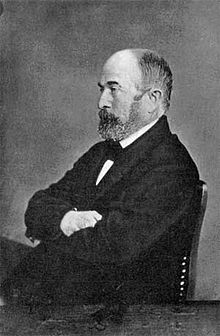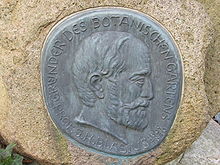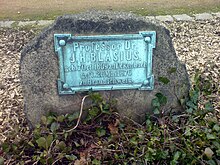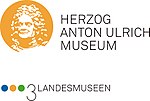Johann Heinrich Blasius
Johann Heinrich Blasius (born October 7, 1809 in Nümbrecht - Eckenbach , Cologne district ; † May 26, 1870 in Braunschweig ) was a German zoologist .
Life
After graduating from higher education in 1831, he taught mathematics, natural history and German in Krefeld. Blasius studied mathematics, geography, geology, zoology and botany in Berlin from 1834. In 1836 he was appointed associate professor (since 1842 full professor) for descriptive natural sciences at the Collegium Carolinum in Braunschweig, where he worked until his death. He campaigned for the construction of a botanical garden. This led to the foundation of the Braunschweig Botanical Garden in 1840 .
Even before his appointment, he had toured large parts of Eastern Europe with his friend Alexander Graf Keyserling ; the results of these research trips were published jointly in 1840. This was followed by a joint trip to Russia in 1840 and 1841, about which Blasius reported in 1844, as well as further trips to the Alps and Italy. In 1843 he was elected a member of the Leopoldina Scholars' Academy .
In the course of time, Blasius created a collection at the Collegium Carolinum, which in 1857 was combined with the natural history collection of the Ducal Art and Natural History Cabinet, which led to the establishment of the Natural History Museum , of which he was appointed director in 1859. In the museum a bust created by August Howaldt commemorates him.
In addition, he was second from 1844 and first librarian from 1864 at the university, from 1862 to 1866 a member of the board of directors of the Collegium Carolinum and from 1866 director of the Ducal Museum in Braunschweig .
Johann Heinrich Blasius was the father of the doctor, bacteriologist and ornithologist Rudolf Blasius and of the ornithologist Wilhelm Blasius .
Together with his sons he carried out field observations in the nature reserve Riddagshausen ponds and described several animal species.
His grave is next to that of his wife Luise, geb. Thiele (1822–1886) in the cemetery of the Reformed Congregation in Juliusstrasse.
Works
- 1840: Europe's vertebrates. (together with Alexander Graf Keyserling ).
- 1844: Journey in European Russia in the years 1840 and 1841. 2 volumes.
- 1857: Natural history of the mammals in Germany. Also fauna of the vertebrate animals of Germany.
literature
- Jürgen Hevers: The portrait bust of Johann Heinrich Blasius in the State Natural History Museum in Braunschweig. In: Braunschweiger Naturkundliche Schriften. Volume 10 (2011), pp. 123-148, ISSN 0174-3384
- Oscar Schmidt : Blasius, Johann Heinrich . In: Allgemeine Deutsche Biographie (ADB). Volume 2, Duncker & Humblot, Leipzig 1875, p. 695 f.
- Erwin Stresemann : Blasius, Johann Heinrich. In: New German Biography (NDB). Volume 2, Duncker & Humblot, Berlin 1955, ISBN 3-428-00183-4 , p. 289 f. ( Digitized version ).
Web links
- Works by and about Johann Heinrich Blasius in the German Digital Library
- Johann Heinrich Blasius as a personality in BLIK - Braunschweig guidance and information system for culture on braunschweig.de
- History of the Braunschweig Botanical Garden at tu-braunschweig.de
- History of the State Natural History Museum Braunschweig on 3landesmuseen.de
- Schiek microscope in Berlin delivered to JH Blasius for his son Rudolf Heinrich Paul Blasius
Individual evidence
- ^ History of the State Natural History Museum Braunschweig 3landesmuseen.de
- ↑ In memory of Johann Heinrich Blasius ( Memento from January 8, 2013 in the Internet Archive ). For the exhibition at the University Library of Braunschweig in November 2009.
| personal data | |
|---|---|
| SURNAME | Blasius, Johann Heinrich |
| ALTERNATIVE NAMES | Blasius, JH |
| BRIEF DESCRIPTION | German zoologist |
| DATE OF BIRTH | October 7, 1809 |
| PLACE OF BIRTH | Nümbrecht -Eckenbach, Cologne district |
| DATE OF DEATH | May 26, 1870 |
| Place of death | Braunschweig |





